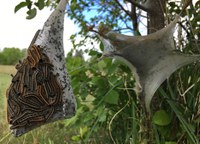Dakota Gardener: Your Neck of the Woods
(Click an image below to view a high-resolution image that can be downloaded)
By Joe Zeleznik, Forester
NDSU Extension
“What’s going on in your neck of the woods?”
I love that expression, though admittedly it’s a little weird to ask that in the prairie environment of North Dakota. Regardless, it’s a pretty clear question: What’s happening where you are?
When I ask this question, the context is most often about the trees. What’s going on with the trees in your area? Are some doing better than others? Probably so. What have people been seeing around North Dakota this spring? Here’s what I’ve seen and heard.
As we all know, it’s dry, dry, dry. This past week, we planted about 40 trees at the Myra Arboretum near Larimore, in western Grand Forks County.
The crew at the Arboretum pre-dug many of the holes the day before planting. Then they added a bucket of water to each hole. By the time we planted the next day, all that water was gone.
Following planting, we immediately added another bucket of water to the soil around each newly planted tree. That helped, but those trees will definitely need additional moisture if they’re going to survive. Make sure that your own trees are getting enough water, especially those younger or smaller trees that were planted in the last few years.
We’re also seeing tip dieback on some young maples and especially birch trees. Reports have come in from Valley City, Bismarck, Minot and elsewhere. Many different types of birch are affected: paper birch, Asian white birch, grey birch and river birch all have shown dieback.
Birch trees are interesting to me. They need full sunlight, but they also need a cool, moist soil. That’s a tricky combination to achieve, especially in urban environments.
Early season defoliators are showing up, which is normal. In eastern North Dakota and western Minnesota, the eastern tent caterpillar has been seen chowing down on chokecherry leaves. These insects are easily controlled by physically removing the nests at night, when the larvae are all together after feeding all day. While it might be tempting to use a blowtorch to burn out the nests, that also will damage the tree, perhaps even more than the damage caused by the insects’ feeding.
The cankerworm outbreak that was widespread in central North Dakota in 2020 hasn’t been so bad this year, at least so far. Usually, we don’t notice these insects until the damage is pretty bad, far beyond the time that they can be controlled. For more information on controlling cankerworms, please see the NDSU Extension publication “Cankerworms in North Dakota” at https://www.ag.ndsu.edu/publications/lawns-gardens-trees/cankerworms-in-north-dakota.
Finally, a lot of spruce and pine trees are showing damage in many parts of the state. In 2020, ponderosa pines were dying in many places, due mainly to the wet fall of 2019. This delayed effect still is showing up on ponderosa pines.
The midwinter warm spell that we had in 2021 damaged Colorado blue spruce throughout the state. Add in the stress from the drought, and it’s a difficult situation.
Does all of this have a bright side? As an educator, I see an opportunity for people to learn more about tree care and about planting the right tree in the right place. Birch trees need cool, moist soils and do best in areas with a north-facing slope, and near the bottom of a slope where moisture will collect. Spruce and pine do terrible in low areas, or anywhere that water pools.
This will be a challenging year for trees. Most will make it, but some won’t. Do your best.
For more information about gardening, contact your local NDSU Extension agent. Find the Extension office for your county at https://www.ag.ndsu.edu/extension/directory/counties.
NDSU Agriculture Communication - June 1, 2021
Source: Joe Zeleznik, 701-231-8143, joseph.zeleznik@ndsu.edu
Editor: Ellen Crawford, 701-231-5391, ellen.crawford@ndsu.edu




